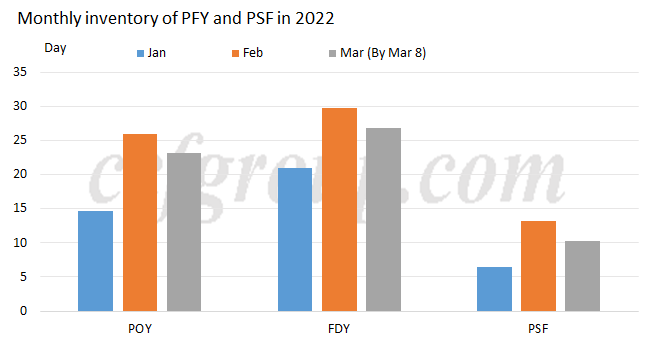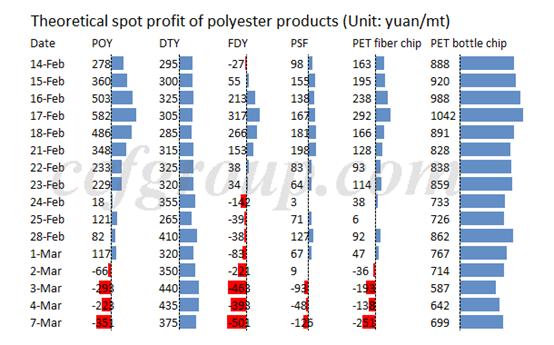Polyester: will production curtailment expand?
Many market players had one question in their mind since late-Feb: won’t polyester companies scale down their production?
High inventory was the major reason for production curtailment. Sales of polyester products were lackluster in Jan and Feb. The inventory has been far higher than the same period of previous years and the accumulation speed is likely to accelerate after polyester polymerization rate up to high.
Polyester market recovered in Feb, with polymerization rate up to above 92% from around 82%, which is estimated to ascend to 94% by Mar 11 based on the assessment made by CCFGroup. More and more PTA and MEG plants released news to have turnaround, while polyester enterprises seemed to be very calm.
However, some polyester enterprises, mainly PSF and PFY plants, announced to have turnaround later on Mar 8.
| Company | Location | Capacity (kt) | Shut | Products |
| Xingbang | Chuzhou | 200 | End-Mar | PSF |
| Lianda | Xiaoshan | 180 | End-Mar/early-Apr | PFY |
| Senkai | Xiaoshan | 360 | End-Mar/early-Apr | PFY |
| Rongsheng | Xiaoshan | 100 | Mar | PFY |
| Sinopec Yizheng | Yizheng | 80 | Mar | PSF |
| Yida | Suqian | 200 | Mid-Mar | PSF |
| Sanfame | Jiangyin | 200 | Mid-Mar | PSF |
According to this schedule, polyester polymerization rate may be hard to approach 94% and it is likely to start falling after reached 93.5% this week.
As some enterprises will resume operation from turnaround during this period and some plants still do not confirm their maintenance time or will not start turnaround until end-Mar/early-Apr, it will have limited effect on the polyester polymerization rate in Mar, which is expected to be at 92-93%.
The reasons for turnaround
Firstly, high inventory posed pressure on polyester plants. The inventory of PFY was especially high. If downstream plants do not restock and start suspending production, the inventory of PFY is expected to accelerate mounting.

Secondly, the cash flow of polyester products based on spot raw material prices has been during negative territory. Polyester companies were profitable in Feb although sales were stunted. However, recent situation was deteriorating rapidly.
Prices of polyester products were hard to chase up when prices of raw materials rose quickly while downstream demand sustained weak. Polyester companies turned to suffer losses and the deficit was increasing. If raw material prices rapidly fall, market status will be tolerable. However, it is very difficult to see decreasing cost based on the status quo.

The signal of production curtailment is only a start. How it will fare later depending on the durability of downstream plants and the actions of large polyester enterprises.
In short run, polyester enterprises with scant raw material inventory and low stocks of finished goods will announce to cut or suspend production. Large polyester companies with high inventory and ample capital are unlikely to reduce production to secure market share.
In medium-to-long run, if crude oil prices tend to continue increasing, raw material producers are likely to be faster in cutting or suspending production than polyester enterprises as PTA and MEG plants have suffered great losses now. If the settlement price of raw materials is high in Mar, the inventory of raw materials and finished goods may also face pressure in being profitable. Stocks of finished goods may be high at that time and the capital pressure is anticipated to be bigger than now. That means more polyester companies may consider to scale down or suspend production. If crude oil price falls from high level, polyester products will have risk to be devaluated. Production reduction and suspension will also increase.
- Top keywords
- Cotton Price
- Cotton Futures Price
- Cotton Futures
- CZCE
- PTA Futures Price
- Chemical Fiber
- Polyester Prices
- Wool price
- PTA Futures
- Shengze Silk
- China
- Yarn Price
- price
- China Textile City
- Fibre Price
- Benzene Price
- Cotton
- Index
- Cotton Index
- PTA
- fabric price
- NYMEX
- Top 10
- textile industry
- Spot Cotton
- Cotton Yarn
- Polyester Price
- Futures
- PTA Price
- cotton yarn price

